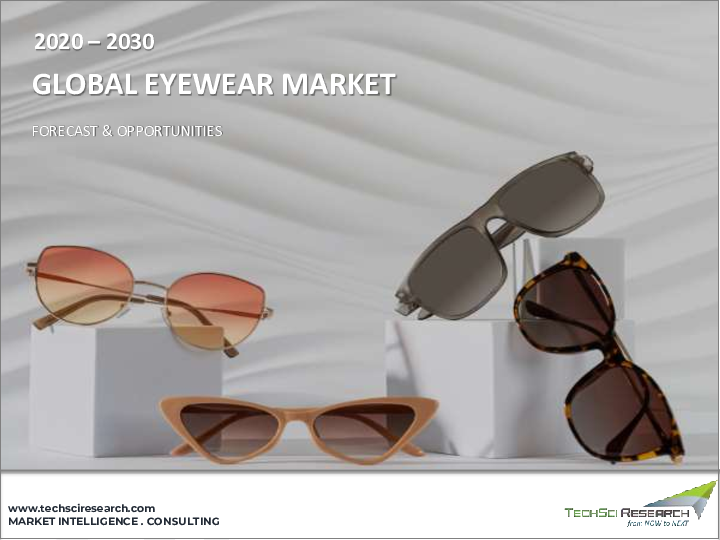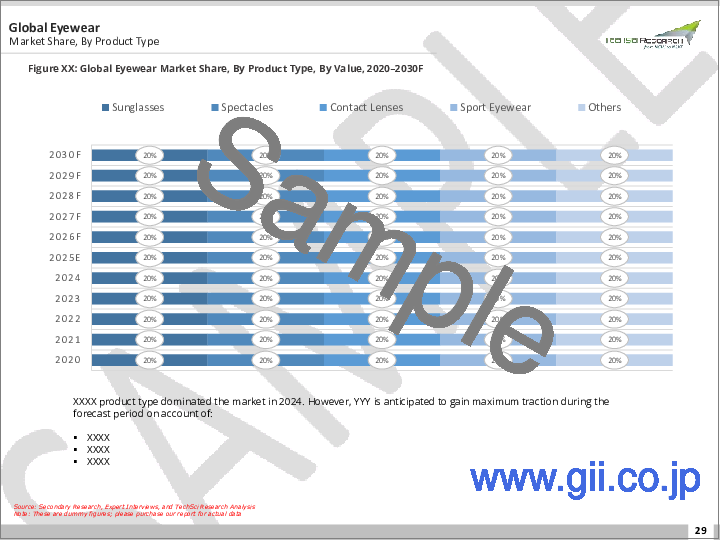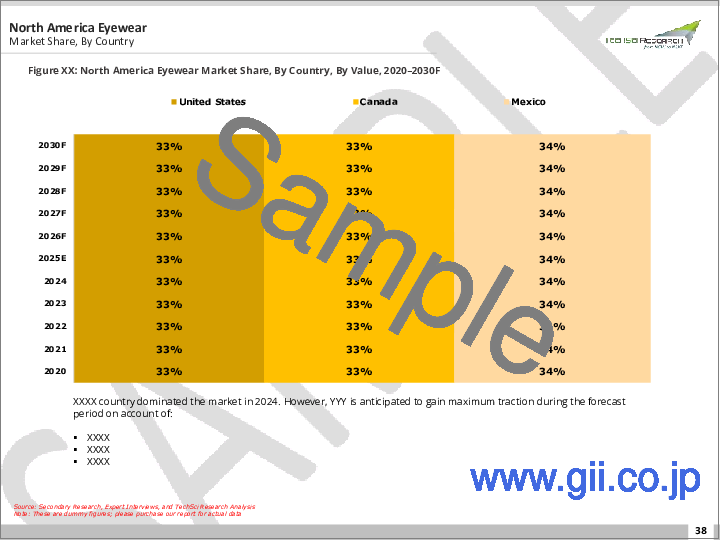|
|
市場調査レポート
商品コード
1771155
アイウェア市場- 世界の産業規模、シェア、動向、機会、予測、製品タイプ別、流通チャネル別、地域別、市場競合、2020-2030年Eyewear Market - Global Industry Size, Share, Trends, Opportunity and Forecast, By Product Type, By Distribution Channel, By Region & Competition, 2020-2030F |
||||||
カスタマイズ可能
|
|||||||
| アイウェア市場- 世界の産業規模、シェア、動向、機会、予測、製品タイプ別、流通チャネル別、地域別、市場競合、2020-2030年 |
|
出版日: 2025年07月14日
発行: TechSci Research
ページ情報: 英文 188 Pages
納期: 2~3営業日
|
全表示
- 概要
- 目次
アイウェアの世界市場は、2024年には2,014億2,000万米ドルとなり、2030年には3,277億9,000万米ドルに達し、CAGR 8.45%で成長すると予測されています。
この成長の原動力となっているのは、視力の健康に対する意識の高まり、スクリーンへの露出の増加、ファッションやライフスタイル動向の影響力の拡大です。同市場では、処方眼鏡、コンタクトレンズ、スタイリッシュなサングラスに対する幅広い年齢層の強い需要が見られます。ブルーライト遮断レンズやスマートアイウェアなどの技術革新が、実用性と魅力の両方を高めています。同時に、eコマース・プラットフォームやデジタル試着ツールの台頭は、アイウェアをより身近でパーソナライズされたものにすることで、消費者の購買習慣を変化させています。先進諸国では人口の高齢化が進み、新興経済諸国では可処分所得が増加していることも、市場浸透の拡大に寄与しています。新興国市場におけるヘルスケア・インフラと視力ケア・サービスの充実は、市場の長期的な拡大をさらに後押ししています。
| 市場概要 | |
|---|---|
| 予測期間 | 2026-2030 |
| 市場規模:2024年 | 2,014億2,000万米ドル |
| 市場規模:2030年 | 3,277億9,000万米ドル |
| CAGR:2025年~2030年 | 8.45% |
| 急成長セグメント | オンライン |
| 最大市場 | アジア太平洋 |
市場促進要因
視力障害とデジタル眼精疲労の増加
主な市場課題
ブランド製品および技術的に高度な製品の高コストアイウェア
主要市場動向
持続可能で環境に配慮したアイウェアの急増
目次
第1章 イントロダクション
第2章 調査手法
第3章 エグゼクティブサマリー
第4章 顧客の声
第5章 世界のアイウェア市場展望
- 市場規模・予測
- 金額別
- 市場シェア・予測
- 製品タイプ別(サングラス、メガネ、コンタクトレンズ、スポーツアイウェア、その他)
- 流通チャネル別(スーパーマーケット/ハイパーマーケット、専門店、オンライン、その他)
- 地域別
- 企業別(2024)
- 市場マップ
第6章 北米のアイウェア市場展望
- 市場規模・予測
- 市場シェア・予測
- 北米:国別分析
- 米国
- カナダ
- メキシコ
第7章 欧州のアイウェア市場展望
- 市場規模・予測
- 市場シェア・予測
- 欧州:国別分析
- フランス
- ドイツ
- スペイン
- イタリア
- 英国
第8章 アジア太平洋地域のアイウェア市場展望
- 市場規模・予測
- 市場シェア・予測
- アジア太平洋地域:国別分析
- 中国
- 日本
- インド
- ベトナム
- 韓国
第9章 中東・アフリカのアイウェア市場展望
- 市場規模・予測
- 市場シェア・予測
- 中東・アフリカ:国別分析
- 南アフリカ
- サウジアラビア
- アラブ首長国連邦
- トルコ
第10章 南米のアイウェア市場展望
- 市場規模・予測
- 市場シェア・予測
- 南米:国別分析
- ブラジル
- アルゼンチン
- コロンビア
第11章 市場力学
- 促進要因
- 課題
第12章 市場動向と発展
- 合併と買収
- 製品上市
- 最近の動向
第13章 混乱:紛争、パンデミック、貿易障壁
第14章 ポーターのファイブフォース分析
- 業界内の競合
- 新規参入の可能性
- サプライヤーの力
- 顧客の力
- 代替品の脅威
第15章 競合情勢
- 企業プロファイル
- EssilorLuxottica SA
- Bausch Health Companies Inc.
- Johnson & Johnson Services Inc.
- The Cooper Companies Inc
- Alcon Vision LLC
- Feilmann AG
- Carl Zeiss Meditec AG
- Safilo Group S.p.A
- De Rigo Vision S.p.A.
- Zenni Optical Inc.
第16章 戦略的提言
第17章 調査会社について・免責事項
The Global Eyewear Market was valued at USD 201.42 Billion in 2024 and is projected to reach USD 327.79 Billion by 2030, growing at a CAGR of 8.45%. This growth is fueled by rising vision health awareness, increased screen exposure, and the expanding influence of fashion and lifestyle trends. The market is witnessing strong demand across age groups for prescription glasses, contact lenses, and stylish sunglasses. Technological innovations such as blue light-blocking lenses and smart eyewear are adding both utility and appeal. Simultaneously, the rise of e-commerce platforms and digital try-on tools is transforming consumer purchasing habits by making eyewear more accessible and personalized. Aging populations in developed countries and rising disposable incomes in emerging economies are also contributing to increased market penetration. Enhanced healthcare infrastructure and vision care services in developing regions further support long-term market expansion.
| Market Overview | |
|---|---|
| Forecast Period | 2026-2030 |
| Market Size 2024 | USD 201.42 Billion |
| Market Size 2030 | USD 327.79 Billion |
| CAGR 2025-2030 | 8.45% |
| Fastest Growing Segment | Online |
| Largest Market | Asia Pacific |
Key Market Drivers
Rising Prevalence of Vision Disorders and Digital Eye Strain
The increasing prevalence of vision disorders, including myopia, hyperopia, astigmatism, and presbyopia, is a major growth driver for the global eyewear market. This trend is largely driven by prolonged exposure to digital screens, affecting both children and adults. In 2023, approximately 66% of adults in the U.S. relied on some form of vision correction. The widespread use of digital devices for work, education, and entertainment is resulting in a sharp rise in digital eye strain and related vision impairments. Consequently, there is growing demand for prescription eyewear and contact lenses with features like blue light filtration and anti-glare coatings.
In addition, the aging global population is contributing to the increase in presbyopia and other age-related eye conditions. According to the World Health Organization, more than 2.2 billion people worldwide live with some form of vision impairment, creating a vast consumer base for corrective eyewear. This sustained and growing need for optical solutions continues to drive market expansion across both developed and emerging markets.
Key Market Challenges
High Cost of Branded and Technologically Advanced Eyewear Products
The high cost of premium eyewear remains a significant barrier to widespread adoption, particularly in price-sensitive markets. Designer frames, lenses with specialized coatings, and advanced eyewear such as smart glasses carry elevated price tags that often place them beyond the reach of middle-income consumers. Products featuring photochromic technology, blue light filters, and augmented reality functions typically involve higher manufacturing costs, which are passed on to consumers.
In regions where vision insurance is limited or absent, consumers often delay or forgo purchasing new eyewear due to affordability concerns. This challenge is especially pronounced in developing regions across Asia and Latin America, where vision care services are less accessible and public reimbursement schemes are lacking. Even in developed markets, the combined costs of eye exams, prescription lenses, and frame fittings can pose financial challenges for underinsured populations. These factors limit sales volume and slow down the market's expansion, particularly in premium and technologically advanced segments.
Key Market Trends
Surge of Sustainable & Eco-Conscious Eyewear
Sustainability has emerged as a key trend in the eyewear industry, shifting from a niche initiative to a mainstream strategy embraced across all market segments. Brands are increasingly integrating circular-economy principles into their product design and supply chain operations. Bio-based acetates made from renewable resources like cotton and wood pulp are replacing petroleum-derived plastics, and recycled materials-such as ocean plastics and discarded fishing nets-are being transformed into stylish, functional eyewear.
Notable brands such as Gentle Monster and Kering's Maison labels are showcasing plant-based and traceable materials in their seasonal collections. Start-ups like Bird Eyewear, Sea2See, and Parafina are championing upcycled materials, while retailers are supporting the trend with take-back programs, repair services, and recycling options. Contact lens manufacturers are also joining the sustainability movement by experimenting with water-soluble packaging and mail-back recycling systems.
The focus is now on measurable environmental impact, with certifications like B-Corp and ISO 14067 becoming more prevalent. As regulators in the EU, Japan, and several U.S. states impose stricter rules on sustainability claims, transparency in sourcing and lifecycle assessments is becoming standard. This evolution positions eco-conscious design and responsible supply chain management as defining features of the future eyewear market, rather than premium exceptions.
Key Market Players
- EssilorLuxottica SA
- Bausch Health Companies Inc.
- Johnson & Johnson Services Inc.
- The Cooper Companies Inc
- Alcon Vision LLC
- Feilmann AG
- Carl Zeiss Meditec AG
- Safilo Group S.p.A
- De Rigo Vision S.p.A.
- Zenni Optical Inc.
Report Scope:
In this report, the Global Eyewear Market has been segmented into the following categories, in addition to the industry trends which have also been detailed below:
Eyewear Market, By Product Type:
- Sunglasses
- Spectacles
- Contact Lenses
- Sport Eyewear
- Others
Eyewear Market, By Distribution Channel:
- Supermarkets/Hypermarkets
- Specialty Stores
- Online
- Others
Eyewear Market, By Region:
- North America
- United States
- Canada
- Mexico
- Europe
- France
- United Kingdom
- Italy
- Germany
- Spain
- Asia-Pacific
- China
- Japan
- India
- South Korea
- Vietnam
- South America
- Argentina
- Colombia
- Brazil
- Middle East & Africa
- South Africa
- Saudi Arabia
- UAE
- Turkey
Competitive Landscape
Company Profiles: Detailed analysis of the major companies present in the Global Eyewear Market.
Available Customizations:
Global Eyewear Market report with the given market data, TechSci Research offers customizations according to a company's specific needs. The following customization options are available for the report:
Company Information
- Detailed analysis and profiling of additional market players (up to five).
Table of Contents
1. Introduction
- 1.1. Market Overview
- 1.2. Key Highlights of the Report
- 1.3. Market Coverage
- 1.4. Market Segments Covered
- 1.5. Research Tenure Considered
2. Research Methodology
- 2.1. Methodology Landscape
- 2.2. Objective of the Study
- 2.3. Baseline Methodology
- 2.4. Formulation of the Scope
- 2.5. Assumptions and Limitations
- 2.6. Sources of Research
- 2.7. Approach for the Market Study
- 2.8. Methodology Followed for Calculation of Market Size & Market Shares
- 2.9. Forecasting Methodology
3. Executive Summary
- 3.1. Overview of the Market
- 3.2. Overview of Key Market Segmentations
- 3.3. Overview of Key Market Players
- 3.4. Overview of Key Regions
- 3.5. Overview of Market Drivers, Challenges, and Trends
4. Voice of Customer
- 4.1. Brand Awareness
- 4.2. Factor Influencing Purchase Decision
5. Global Eyewear Market Outlook
- 5.1. Market Size & Forecast
- 5.1.1. By Value
- 5.2. Market Share & Forecast
- 5.2.1. By Product Type (Sunglasses, Spectacles, Contact Lenses, Sport Eyewear, Others )
- 5.2.2. By Distribution Channel (Supermarkets/Hypermarkets, Specialty Stores, Online, Others)
- 5.2.3. By Region
- 5.2.4. By Company (2024)
- 5.3. Market Map
6. North America Eyewear Market Outlook
- 6.1. Market Size & Forecast
- 6.1.1. By Value
- 6.2. Market Share & Forecast
- 6.2.1. By Product Type
- 6.2.2. By Distribution Channel
- 6.2.3. By Country
- 6.3. North America: Country Analysis
- 6.3.1. United States Eyewear Market Outlook
- 6.3.1.1. Market Size & Forecast
- 6.3.1.1.1. By Value
- 6.3.1.2. Market Share & Forecast
- 6.3.1.2.1. By Product Type
- 6.3.1.2.2. By Distribution Channel
- 6.3.1.1. Market Size & Forecast
- 6.3.2. Canada Eyewear Market Outlook
- 6.3.2.1. Market Size & Forecast
- 6.3.2.1.1. By Value
- 6.3.2.2. Market Share & Forecast
- 6.3.2.2.1. By Product Type
- 6.3.2.2.2. By Distribution Channel
- 6.3.2.1. Market Size & Forecast
- 6.3.3. Mexico Eyewear Market Outlook
- 6.3.3.1. Market Size & Forecast
- 6.3.3.1.1. By Value
- 6.3.3.2. Market Share & Forecast
- 6.3.3.2.1. By Product Type
- 6.3.3.2.2. By Distribution Channel
- 6.3.3.1. Market Size & Forecast
- 6.3.1. United States Eyewear Market Outlook
7. Europe Eyewear Market Outlook
- 7.1. Market Size & Forecast
- 7.1.1. By Value
- 7.2. Market Share & Forecast
- 7.2.1. By Product Type
- 7.2.2. By Distribution Channel
- 7.2.3. By Country
- 7.3. Europe: Country Analysis
- 7.3.1. France Eyewear Market Outlook
- 7.3.1.1. Market Size & Forecast
- 7.3.1.1.1. By Value
- 7.3.1.2. Market Share & Forecast
- 7.3.1.2.1. By Product Type
- 7.3.1.2.2. By Distribution Channel
- 7.3.1.1. Market Size & Forecast
- 7.3.2. Germany Eyewear Market Outlook
- 7.3.2.1. Market Size & Forecast
- 7.3.2.1.1. By Value
- 7.3.2.2. Market Share & Forecast
- 7.3.2.2.1. By Product Type
- 7.3.2.2.2. By Distribution Channel
- 7.3.2.1. Market Size & Forecast
- 7.3.3. Spain Eyewear Market Outlook
- 7.3.3.1. Market Size & Forecast
- 7.3.3.1.1. By Value
- 7.3.3.2. Market Share & Forecast
- 7.3.3.2.1. By Product Type
- 7.3.3.2.2. By Distribution Channel
- 7.3.3.1. Market Size & Forecast
- 7.3.4. Italy Eyewear Market Outlook
- 7.3.4.1. Market Size & Forecast
- 7.3.4.1.1. By Value
- 7.3.4.2. Market Share & Forecast
- 7.3.4.2.1. By Product Type
- 7.3.4.2.2. By Distribution Channel
- 7.3.4.1. Market Size & Forecast
- 7.3.5. United Kingdom Eyewear Market Outlook
- 7.3.5.1. Market Size & Forecast
- 7.3.5.1.1. By Value
- 7.3.5.2. Market Share & Forecast
- 7.3.5.2.1. By Product Type
- 7.3.5.2.2. By Distribution Channel
- 7.3.5.1. Market Size & Forecast
- 7.3.1. France Eyewear Market Outlook
8. Asia-Pacific Eyewear Market Outlook
- 8.1. Market Size & Forecast
- 8.1.1. By Value
- 8.2. Market Share & Forecast
- 8.2.1. By Product Type
- 8.2.2. By Distribution Channel
- 8.2.3. By Country
- 8.3. Asia-Pacific: Country Analysis
- 8.3.1.China Eyewear Market Outlook
- 8.3.1.1. Market Size & Forecast
- 8.3.1.1.1. By Value
- 8.3.1.2. Market Share & Forecast
- 8.3.1.2.1. By Product Type
- 8.3.1.2.2. By Distribution Channel
- 8.3.1.1. Market Size & Forecast
- 8.3.2.Japan Eyewear Market Outlook
- 8.3.2.1. Market Size & Forecast
- 8.3.2.1.1. By Value
- 8.3.2.2. Market Share & Forecast
- 8.3.2.2.1. By Product Type
- 8.3.2.2.2. By Distribution Channel
- 8.3.2.1. Market Size & Forecast
- 8.3.3. India Eyewear Market Outlook
- 8.3.3.1. Market Size & Forecast
- 8.3.3.1.1. By Value
- 8.3.3.2. Market Share & Forecast
- 8.3.3.2.1. By Product Type
- 8.3.3.2.2. By Distribution Channel
- 8.3.3.1. Market Size & Forecast
- 8.3.4. Vietnam Eyewear Market Outlook
- 8.3.4.1. Market Size & Forecast
- 8.3.4.1.1. By Value
- 8.3.4.2. Market Share & Forecast
- 8.3.4.2.1. By Product Type
- 8.3.4.2.2. By Distribution Channel
- 8.3.4.1. Market Size & Forecast
- 8.3.5. South Korea Eyewear Market Outlook
- 8.3.5.1. Market Size & Forecast
- 8.3.5.1.1. By Value
- 8.3.5.2. Market Share & Forecast
- 8.3.5.2.1. By Product Type
- 8.3.5.2.2. By Distribution Channel
- 8.3.5.1. Market Size & Forecast
- 8.3.1.China Eyewear Market Outlook
9. Middle East & Africa Eyewear Market Outlook
- 9.1. Market Size & Forecast
- 9.1.1. By Value
- 9.2. Market Share & Forecast
- 9.2.1. By Product Type
- 9.2.2. By Distribution Channel
- 9.2.3. By Country
- 9.3. MEA: Country Analysis
- 9.3.1. South Africa Eyewear Market Outlook
- 9.3.1.1. Market Size & Forecast
- 9.3.1.1.1. By Value
- 9.3.1.2. Market Share & Forecast
- 9.3.1.2.1. By Product Type
- 9.3.1.2.2. By Distribution Channel
- 9.3.1.1. Market Size & Forecast
- 9.3.2. Saudi Arabia Eyewear Market Outlook
- 9.3.2.1. Market Size & Forecast
- 9.3.2.1.1. By Value
- 9.3.2.2. Market Share & Forecast
- 9.3.2.2.1. By Product Type
- 9.3.2.2.2. By Distribution Channel
- 9.3.2.1. Market Size & Forecast
- 9.3.3. UAE Eyewear Market Outlook
- 9.3.3.1. Market Size & Forecast
- 9.3.3.1.1. By Value
- 9.3.3.2. Market Share & Forecast
- 9.3.3.2.1. By Product Type
- 9.3.3.2.2. By Distribution Channel
- 9.3.3.1. Market Size & Forecast
- 9.3.4. Turkey Eyewear Market Outlook
- 9.3.4.1. Market Size & Forecast
- 9.3.4.1.1. By Value
- 9.3.4.2. Market Share & Forecast
- 9.3.4.2.1. By Product Type
- 9.3.4.2.2. By Distribution Channel
- 9.3.4.1. Market Size & Forecast
- 9.3.1. South Africa Eyewear Market Outlook
10. South America Eyewear Market Outlook
- 10.1. Market Size & Forecast
- 10.1.1. By Value
- 10.2. Market Share & Forecast
- 10.2.1. By Product Type
- 10.2.2. By Distribution Channel
- 10.2.3. By Country
- 10.3. South America: Country Analysis
- 10.3.1. Brazil Eyewear Market Outlook
- 10.3.1.1. Market Size & Forecast
- 10.3.1.1.1. By Value
- 10.3.1.2. Market Share & Forecast
- 10.3.1.2.1. By Product Type
- 10.3.1.2.2. By Distribution Channel
- 10.3.1.1. Market Size & Forecast
- 10.3.2. Argentina Eyewear Market Outlook
- 10.3.2.1. Market Size & Forecast
- 10.3.2.1.1. By Value
- 10.3.2.2. Market Share & Forecast
- 10.3.2.2.1. By Product Type
- 10.3.2.2.2. By Distribution Channel
- 10.3.2.1. Market Size & Forecast
- 10.3.3. Colombia Eyewear Market Outlook
- 10.3.3.1. Market Size & Forecast
- 10.3.3.1.1. By Value
- 10.3.3.2. Market Share & Forecast
- 10.3.3.2.1. By Product Type
- 10.3.3.2.2. By Distribution Channel
- 10.3.3.1. Market Size & Forecast
- 10.3.1. Brazil Eyewear Market Outlook
11. Market Dynamics
- 11.1. Drivers
- 11.2. Challenges
12. Market Trends & Developments
- 12.1. Merger & Acquisition (If Any)
- 12.2. Product Launches (If Any)
- 12.3. Recent Developments
13. Disruptions: Conflicts, Pandemics and Trade Barriers
14. Porters Five Forces Analysis
- 14.1. Competition in the Industry
- 14.2. Potential of New Entrants
- 14.3. Power of Suppliers
- 14.4. Power of Customers
- 14.5. Threat of Substitute Products
15. Competitive Landscape
- 15.1. Company Profiles
- 15.1.1. EssilorLuxottica SA
- 15.1.1.1. Business Overview
- 15.1.1.2. Company Snapshot
- 15.1.1.3. Products & Services
- 15.1.1.4. Financials (As Per Availability)
- 15.1.1.5. Key Market Focus & Geographical Presence
- 15.1.1.6. Recent Developments
- 15.1.1.7. Key Management Personnel
- 15.1.2. Bausch Health Companies Inc.
- 15.1.3. Johnson & Johnson Services Inc.
- 15.1.4. The Cooper Companies Inc
- 15.1.5. Alcon Vision LLC
- 15.1.6. Feilmann AG
- 15.1.7. Carl Zeiss Meditec AG
- 15.1.8. Safilo Group S.p.A
- 15.1.9. De Rigo Vision S.p.A.
- 15.1.10. Zenni Optical Inc.
- 15.1.1. EssilorLuxottica SA





